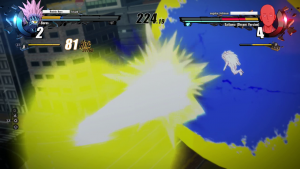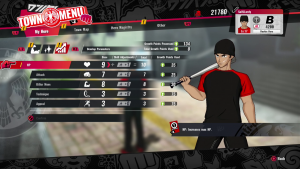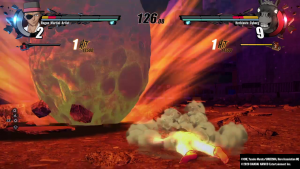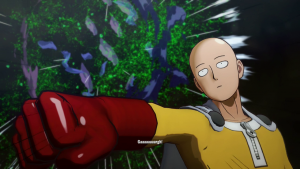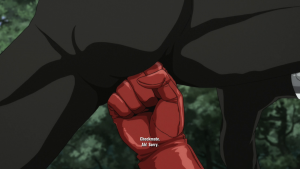After last year’s release of “Shonen Jump” celebratory fighting game “Jump Force” gained mixed to negative reviews from hardcore anime fans and gamers alike, Spike Chunsoft’s next foray into digitizing an anime adaptation was scaled back quite a bit with the focus solely being on one series. After gaining popularity for the sheer absurdity of its premise – a self-trained superhero who is strong enough to obliterate enemies by hitting them once – “One Punch Man” didn’t seem poised for a gaming experience, but the developers figured out a way to get around this special trait housed by the franchise’s titular figure. I didn’t know what to exactly expect from “A Hero Nobody Knows” other than it being similar to last year’s “Jump Force” from a gameplay perspective.
Did I Complete “One Punch Man: A Hero Nobody Knows”?
Rather than give the player a typical start-up menu where they can choose what they want to do first, “A Hero Nobody Knows” thrusts the player into the game’s story with the requirement of crafting an avatar to play with instead of “One Punch Man” himself Saitama. The character creation tool features parts & pieces that can be expanded upon by purchasing items in various shops or unlocked through successful battles & missions. From the hub impressively fashioned as City-Z from “One Punch Man’s” other adaptations, the player and their created avatar are allowed to complete the main narrative that took yours truly some eight hours to finish with one mandatory fight late in the game consuming three of those eight hours alone due to some of the game’s core systems as well as a giant difficulty boost.
Side missions and certain challenges were also finished during these eight hours, but the full platinum trophy experience was not for me considering the amount of grinding necessary to reach such statuses as “Hero Rank S” and my created character attaining the highest level possible (which appears to be beyond level fifty considering the trophy list with my created character barely being at level forty by the story’s end). Also from the hub is the ability to fight offline & online with the latter taking up another hour of my time thanks to a rather active community and solid connectivity.
Did “One Punch Man: A Hero Nobody Knows” Live Up to the Hype?
Like several other Spike Chunsoft-developed games before it, “One Punch Man” features a relatively simple battle system with the player being able to pull off auto combos by hitting the “light strike” button that will send an opponent flying or knock them into the dirt following the conclusive attack. Players can also utilize “strong strikes” to push back, launch or sweep opponents; as well as charge both light and strong strikes to break an opposition’s guard with the adversary potentially stopping a charged attack if they hit their enemy quickly enough. Blocking & throwing really tie into one another as throws can stop a habitual blocker such as every AI enemy in the story mode. With great timing the player can create moments of “Perfect Guard/Dodges” by hitting the block button right as the player’s character is being hit. Unfortunately unlike “Jump Force”, “Perfect Guard” doesn’t work as effectively as the character who successfully performs the action doesn’t automatically turn around to potentially hit their opponent from behind; leaving the once advantageous fighter prone to another series of attacks. Blocking also only works when someone is standing completely still – slightly touch the analog stick while holding down the block button will completely nullify the character’s guard.
Under the health of each character is a “Stamina” bar that depletes when a character dashes or performs a “Perfect Guard”; making it impossible to continuously rush opponents or perform teleporting blocking techniques. The character’s “Ability” meter beside their profile picture allows for the characters to pull off a variety of special attacks known as “Killer Moves”. “Killer Moves” drain a certain number of “bars” to perform while being be both impressive and, depending on the character, overpowered with unblockable traits. Some characters have “Transformation” abilities if their “Ability” meter reaches the appropriate number. The temporary Transformation of a character boosts their damage output, reduces damage taken by opposing attacks, and even unlocks a “Super Kill Maneuver” that does ridiculous damage. One of the most interesting aspects about the game’s fighting system is the option to switch a created character’s battle styles.
With up to six base styles and variants of those styles, the player has the chance to try out several different ways to accomplish a fight; though some styles like the long-range “Psychic” or “Weapon” styles are better than the short-range specific “Power” offering. Unlike “Jump Force”, the abilities unlocked are style specific; so the player can’t mix & match their favorite “Killer Moves” to make a true superhero even after upgrading said style to its max level of five. There are several RPG elements in regards to upgrading a player’s avatar including spending skill points earned with leveling up to boost the created character’s health, power, the effectiveness of “Killer Moves”, stamina restoration & special meter charging, and the ability to attract other heroes to help a player in battle. These upgrades, however, prove mostly insignificant due to the game’s power scaling of enemies. During missions, the player will be alerted of the difficulty of each mission depicted in the form of red fists. Though the game uses a general numbered level system in regards to the player’s character, it doesn’t when explaining the toughness of an upcoming battle. Enter a “three fist” level fight with an avatar at level ten and you’ll probably get obliterated; but come back at level thirteen and it’ll be a rather easy fight.
Like the source material, “A Hero Nobody Knows” embraces the absurdity of everything that happens in a battle during a typical day in City-Z during both the story and when it’s time to throw down including the usage of mid-fight interruptions. Items will be brought in by drones (drones that may or may not explode after delivery) to potentially grant the character who grabs said item temporary strength or defense boosts, or may even restore said character’s health. Situations like comets raining to the earth, lightning strikes, and even moles can turn a fight upside-down, as well as heroes just randomly appearing. These unpredictable moments sound fun in theory and mostly are at the start, but when the player is in the middle of a tough fight and a meteor shower begins that results in the player losing because they can’t avoid the comets it makes for one of the most frustrating experiences possible in a fighting game.
During certain fights heroes and villains will enter the fray as long as the initial fighter lives long enough – adding another health bar the opposition must deplete to win. Certain actions like performing Perfect Guards will decrease the time it takes for that support character to arrive. For some battles it’s totally unnecessary to hold on as an enemy will be defeated in short order. Other times the player will be desperate for help especially during the missions specifically made to progress the story. Said story missions where the enemy greatly outclasses the player’s avatar, the player must survive long enough for a cutscene to usher the arrival of Saitama for a one-punch victory – making all the player’s hard work feel meaningless in comparison just like for the celebrated heroes in the other “One Punch Man” adaptations.
Considering that this game’s story is just an abridged version of “One Punch Man” season one, the developers added a great amount of padding including the requirement of the player gaining a certain amount of “Contribution Points” by completing mundane side missions, fetch quests, or the fight sequences located at heroes’ headquarters. These completed extra curriculars not only provide little in terms of numbered rewards, but also unlock extra characters the player can use in the game’s online modes while said new characters usually provide new “Killer Moves”. And when it comes to the actual story, it proves underwhelming as the player’s avatar is simply shoehorned into recreated scenes from the anime as if he or she was actually in the middle of these catastrophic events in City-Z.
The game allows for playing both offline & online with the suggestion of always being connected to the game’s server presenting a mixed bag of qualities. While it’s nice to gain extra experience & items via online-specific events, the game has a nasty habit of drawing in low-level, player-created characters as support for the player’s avatar during exhausting battles that will result in the extra character getting knocked out in a couple of successful hits from an enemy. Being online at all times also causes frame rate drops when moving around City-Z due to avatars continuously loading. In regards to fighting online there are only three options: “Avatar Ranked”, “Team Battle Ranked” and “Free Play”. Only “Free Play” allows for the gamer to control certain actions & exceptions like removing interfering heroes including Saitama. Shockingly, the respective ranked modes utilize all the game’s battle systems including the usage of One Punch Man in battle. Even if Saitami isn’t used by any player, characters that are unlocked later in the game are definitely stronger than the early characters offered to play online – meaning online is less about skill and more about tiers. What makes the game’s ranked modes even worse is the fact there are no filters; meaning a person with a level nine hero could face a level ninety-nine opponent in their first match (which is what exactly what happened to me).
Beyond the aforementioned problems there are some other glaring gameplay issues including the animations & hit boxes in correlation with being knocked down. Each fight outside of online competitive modes features a timer that, when depleted, ends the mission in failure. In latter fights that will drag on as the AI becomes more defensive, being knocked down can mean the difference between success within the time limit and having to restart a battle because the knockdown & get up animations last several seconds no matter the situation. This may not sound like a lot, but those seconds can prove crucial during the game’s tougher fights. If the opponent is aggressive and starts striking combinations near a downed opponents, the rising target will be struck & stuck in a series of attacks unless the adversary can pull off a Perfect Guard – this can be done for or against both AI and humans.
The narrative presentation is also lacking especially in regards to the player’s avatar being muted during cutscenes, though has a voice chosen by the player for pre & post-match dialogue. With a majority of the show’s voice actors not being involved in this, even the voiced scenes are lacking. And then there’s the graphics that mostly look like something from a generation ago including the painted-on look of certain items placed on a created character. There’s also a room/home base each player has that they can modify with purchased & earned furniture, but it means absolutely nothing in the grand scheme of things as it’s only there for aesthetic purposes.
“A Hero Nobody Knows” is a deceptive beast – a game that feels like a dumbed down version of “Jump Force” featuring some of the absurd humor the source material is praised for during both story moments & battles. But the more time you spend with “One Punch Man” the more its flaws become detrimental while presenting another license video game that shouldn’t exist.
Should You Play “One Punch Man: A Hero Nobody Knows”?
It’s extremely hard to even recommend “A Hero Nobody Knows” to the most hardcore of anime-loving gamers or those who simply love 3D arena-style brawlers featuring RPG-influenced systems and a creation tool that can prove absurd depending on what the player unlocks. But the core gameplay implementations – the tier-based gameplay featuring annoying hit boxes & animations; a lackadaisical re-telling of “One Punch Man” season one; paint-by-the-numbers & repetitive side missions – makes “A Hero Nobody Knows” an unfulfilling experience. For those truly desperate for the insanity, a rental is the only way to play this game. Other gamers who don’t want to lose their sanity or simply waste their time on something so underwhelming should avoid “A Hero Nobody Knows” like a punch to the groin from Saitama.


